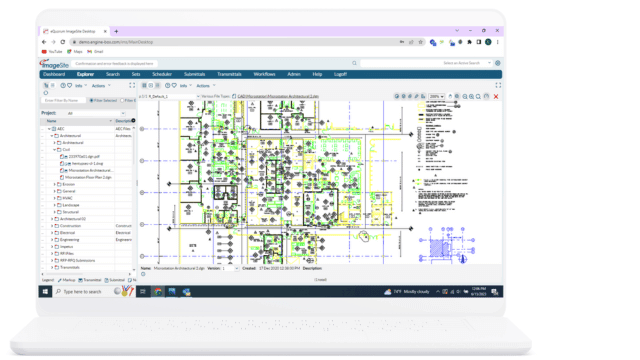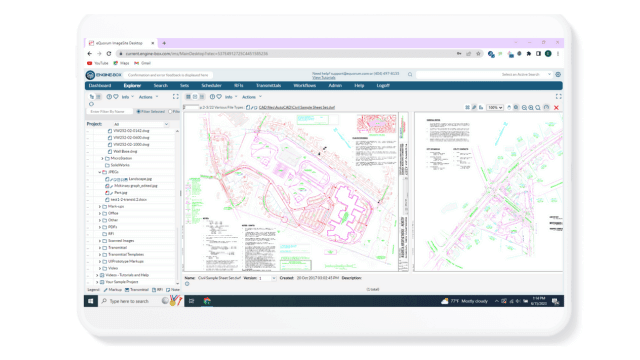Understanding Engineering Workflow Management
Understanding Engineering Workflow Management
Workflow management may be intuitive to some; however, an engineering workflow is often complex and requires careful planning and consideration. Many organizations utilize software to help manage their essential workflows, as it helps administrators keep tight control over reviews, approvals, and deliverables, and enables them to manage document actions at each step, resulting in significant time and cost savings.
Workflow Configuration
While many workflows are linear, there are several ways in which organizations can configure their workflows that enable them to incorporate their review and approval processes. Review and approval workflows start when managers identify the needs, constraints, and deadlines of a project. Once identified, the workflow administrator or project manager (creator of the workflow) needs to identify key members of the team (typically experts of specific disciplines) to review and approve/reject the drawings and documents created/updated by the team.
Once the needs have been identified, the administrator can determine whether the review process includes multiple reviewers, and whether they should include a majority or unanimous voting process. The type of voting depends primarily on the document in question and the compliance requirements of the organization. (Majority voting consists of more than one reviewer assigning their approval among a group of reviewers.) Since the software enables authorized third-parties to access the system, software administrators also can determine which members should be included in the vote.
When creating a workflow, administrators should clearly define goals and timelines, specifying progress in the workflow. (Progress can even be established on an accrual basis that can be used to invoice clients.) ImageSite’s workflow builder enables organizations to display progress as a percentage at each step, providing managers and workflow participants with a clear understanding of what work remains and what has been completed. Workflow creators should ensure that progress is based on the effort it takes to complete each step, rather than the actual number of steps in a workflow.

The Discipline of Workflow Schedule Management
Business operations seem more chaotic than ever. The economic swings seem bigger; the labor pool is tighter, more diverse, and more geographically dispersed; the amount of information is enormous; and at the end of the day, management has just become harder. Trying to get your arms around all that’s going on and ensuring the organization is focused on getting the tasks done is now more complex and daunting. Add pandemics, supply chain disruptions, geopolitical uncertainty, and now even historical inflation.
What is a manager to do?
Workflows for Reporting
Workflow management software helps organizations create feedback loops and gives managers the ability to monitor employee actions, identify data silos, and optimize their workflows accordingly. Creating efficient workflows helps organizations complete projects more quickly, allowing them to focus on other tasks at hand. Since every workflow is located within the system, managers can monitor employee communications to ensure workers are collaborating, yielding better results.
Audit trails enable system administrators and project managers to view all actions taken within the system within a preconfigured engineering workflow or anywhere else in the system. Not only does this enable them to spot inefficiencies, but also helps to spot nefarious actions within the system, either by unauthorized users or by those abusing their privileges.
Interested to learn more?
Let's talk.
Fill out the contact form to schedule a demo of the software. We look forward to speaking with you!
Additional EDMS Features
Our EDMS solutions
ImageSite and EngineBox are eQuorum’s robust workflow and document management solutions, created to help workers manage their essential workflows while maintaining complete control over their engineering files and documents. Not only do they provide a secure collaboration site for workers, but they also help organizations manage document distribution with third parties like vendors, contractors, and customers. Both systems are offered at a competitive price, enabling organizations to get a quick return on their investment by providing the features and functionality needed to help organizations improve efficiency, productivity, and collaboration. Companies can choose from concurrent user subscriptions or named user subscriptions, ensuring organizations have subscription options that make sense for their business.

ImageSite®
Our single source engineering workflow and document management system. Built in HTML5 so there is no software to deploy to client computers or mobile apps to download. Offered as an On-premise or Private Cloud system.
EngineBox™
EngineBox is a cloud based workflow and document management version of ImageSite that resides outside the corporate network.
Our EDMS solutions
ImageSite and EngineBox are eQuorum’s robust workflow and document management solutions, created to help workers manage their essential workflows while maintaining complete control over their engineering files and documents. Not only do they provide a secure collaboration site for workers, but they also help organizations manage document distribution with third parties like vendors, contractors, and customers. Both systems are offered at a competitive price, enabling organizations to get a quick return on their investment by providing the features and functionality needed to help organizations improve efficiency, productivity, and collaboration. Companies can choose from concurrent user subscriptions or named user subscriptions, ensuring organizations have subscription options that make sense for their business.

EngineBox™
EngineBox is a cloud based workflow and document management version of ImageSite that resides outside the corporate network.
The eQuorum Customer Promise
In 2005, eQuorum developed the first all browser-based EDMS. The system, although for on-premise use, was still created to remove client software and JAVA from user computers and allow users to have a single viewer based on the simple navigation functionality of browsers. Today, eQuorum provides that same application in a private Cloud or a SaaS Cloud option. We can do this because we are, and have always been, browser-based, understanding the enhanced speed, security, and usability of this technology.
With the abundance of document management systems on the market today, there’s no doubt that choosing the right Cloud document management software can be a difficult decision. eQuorum is here to provide a comprehensive, powerful, and most importantly – affordable Cloud document management solution. We believe in providing real value to our customers by eliminating unnecessary costs, providing industry-leading functionality, and equipping your team with the right tools using cutting edge technology to bring your products to market faster.
eQuorum®
We specialize in engineering workflow and document management. Our comprehensive, yet easy-to-use software provides the solution to manage data from design to manufacturing and production, to sales, support and administration.